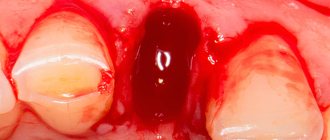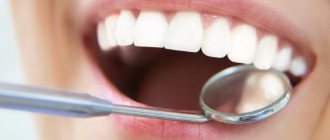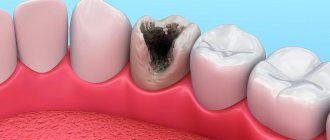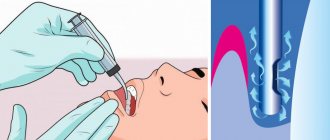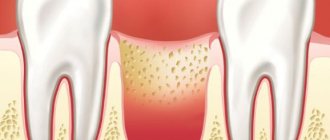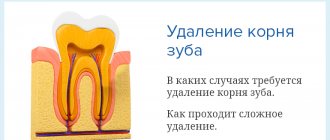Symptoms Causes Consequences Alveolitis Diagnosis and treatment Features of wisdom teeth Treatment at home Prevention
Tooth extraction is one of the most popular and simplest operations in medicine. Usually it passes without complications, but due to a number of general or subjective reasons, deviations may occur. One such postoperative complication is dry socket.
The fact is that after extraction of a tooth, a cavity forms in its place, which, in a positive scenario, is filled with a blood clot. It prevents the penetration of microbes into an open wound and promotes its speedy healing. A dry socket after tooth extraction is the absence of that same blood clot in the socket. This can happen for two reasons:
- Loss or resorption.
- Severe bleeding that prevented a clot from forming.
Whatever the reason, the healing process can take weeks and be accompanied by serious discomfort, which is not always possible to eliminate on your own.
Symptoms
Dry socket syndrome is very painful. It is quite easy to identify if the following symptoms appear within 2-3 days after tooth extraction:
- inflammation of the gums, accompanied by severe pain;
- pain in the cervical region and ears;
- the appearance of bad breath;
- taste of pus in the mouth;
- partial hearing loss;
- general malaise
Visually, a dry socket is an empty depression at the site of tooth growth, first exposing the jawbone, and then turning into a reddened, purulent wound.
Normally, the socket is a cavity that, after tooth extraction, is filled with ichor. Over the next three days, the clot thickens, and light fibrin stripes appear on it - the beginning of the formation of new gum tissue. There may be slight soreness at the wound site. From 4 to 7 days, swelling gradually subsides, and the gums acquire their usual pink color. There is no pain.
What to do after the extraction is complete
It is possible to realize that the hole is healing correctly on the 3rd day. The gums hurt moderately, and a white coating appears on it. It is extremely important not to remove it, since it is new epithelium. After 2 weeks, the onion should be completely covered with granulation tissue. After a month, bone tissue begins to regenerate in the entire socket. After 50 days, bone tissue fills the entire hole. And only after five to six months the hole is completely healed and does not differ from other bone tissue.
The gums will recover faster after tooth extraction is completed if you follow easy recommendations.
In the first days after surgery, minor bleeding may occur. Under such conditions, you need to take a small piece of cotton wool or gauze, soak it in hydrogen peroxide, and apply it to the hole. It is much better to go to the pharmacy immediately after removal and buy a hemostatic sponge. A small piece must be applied to the hole; it will dissolve on its own.
Causes of dry socket
There are several causes of dry socket. Some of them can be prevented by following simple recommendations regarding personal hygiene and caution. Causes:
- smoking. In this case, there is a decrease in pressure in the oral cavity, which can lead to the loss of the formed clot;
- neglect of oral hygiene;
- low blood clotting;
- taking oral contraceptives;
- mechanical damage to the hole itself or the tissues around it.
In addition to the above reasons, a dry socket can appear as a result of an incorrectly performed tooth extraction procedure. During a complex extraction, when the tooth had to be removed from the gums in parts. All rules recommended before and after extraction must be followed.
On the top
The most common complication of extraction of figure eights in the upper jaw is a puncture of the base of the maxillary sinus (maxillary sinus).
Puncture of the bottom of the maxillary sinus
The dental roots of molars number three in the upper jaw are located too close to the base of the sinus, and sometimes even grow into it. Chronic inflammation of the periapical tissue provokes resorption of the axillary septum, due to which the roots of the molars fuse with the mucous membrane inside the sinus. It is this part that most often ruptures during the extraction of the right or left tooth. This complication can be noticed by the following symptoms:
- nasal sound, bleeding air bubbles;
- blood from the nose on the side of the figure eight.
In such a situation, urgent medical assistance is necessary.
Consequences
If during the first two days after tooth extraction pain appears, swelling does not subside and the temperature rises, then most likely these are signs of inflammation. In this case, you should immediately consult a doctor, as dry socket syndrome can lead to serious complications. Such as:
- flux.
It begins to form when an infection gets into the hole. Characterized by severe swelling and pain. Requires immediate specialist intervention. - alveolitis
This is a deeper penetration of the infection - deep into the gums. Bacteria spread quickly and, if this process is not stopped in time, there is a risk of tissue necrosis. In this case, the losses can be very serious.
Attention!
The consequences of untimely or incorrect treatment can be irreversible. Do not neglect your doctor's advice. A wound on the mucous membrane is always a vulnerable area, subject to attack by bacteria and their rapid spread.
Forms of alveolitis
Depending on the course of the complication, three stages are distinguished:
- Serous.
It makes itself felt
2-3 days
after tooth extraction. At this stage, pain occurs when eating, headache. Lymph nodes increase in size. - Purulent.
This is the next form that occurs after the serous one, if timely treatment is not carried out. Diagnosed a week after the tooth was removed. The pain becomes unbearable and is also felt in the head or ear. The hole becomes covered with a purulent, dirty yellow coating. There is an unpleasant odor from the mouth. Swelling and lymph nodes enlarge and become painful. Opening your mouth and eating food is extremely difficult due to pain. - Hypertrophic.
At this stage, it seems that the symptoms are subside: the condition is normalized, the temperature decreases. However, atrophied tissue grows, and when pressure is applied, pus is released from the inflamed wound.
If you notice any of the above symptoms, you should not self-medicate, but rather consult a dentist.
Correction of common complications
General violations occur less and less often in dentists’ offices. This is due to the latest technologies in this area, which allow treatment to be carried out painlessly and quickly, as well as the development of asepsis and antiseptics. But some complications still arise, although this does not happen as often as before.
If the patient’s eyes are cloudy due to fear of intervention, use a cotton swab soaked in ammonia. It is brought 7-10 cm from the nose, which brings the person to his senses. If anxiety does not go away, medical sleep is offered as pain relief.
If there is a large loss of blood during the operation, you need to carefully and promptly make up for the deficiency. Otherwise, vascular disorders develop, including hypovolemic shock and cardiac failure. Therefore, treatment should be carried out only in well-equipped clinics.
Low-grade fever is considered a normal reaction of the body to the intervention. But if it goes beyond 38.5 ºС for several days, you need to inform your doctor about this - the symptom may indicate the onset of a complication.
Diagnosis and treatment methods
Diagnostics at a dentist's appointment will help confirm the symptoms of a dry socket. After an examination, the doctor will prescribe treatment. As a rule, it depends on the stage of inflammation. In the case of a mild form, drug treatment with antiseptics and anti-inflammatory drugs is possible. At the middle stage, you will need antibacterial therapy, as well as cleaning the hole from pus and filling it with an anti-inflammatory drug. All actions are performed under anesthesia. If necessary, antibiotics are prescribed.
At the third stage, the most advanced stage, the patient may need hospitalization and even surgical intervention. With proper care and no complications, the hole heals within seven days. And a month later there is no trace left of her.
Features of wisdom tooth removal
Dry socket after wisdom tooth removal is not uncommon. This syndrome occurs especially often in the lower jaw due to the fact that as a result of swallowing and opening the mouth, the muscles tense, aggravating the appearance of a dry socket and, as a result, alveolitis. Dry socket occurs in approximately 50% of cases
. Due to the anatomical features of the jaw, the blood clot often falls out.
When extracting a wisdom tooth, you must carefully observe precautions and resort to this procedure only in cases of extreme necessity. After all, the inaccessibility of the place complicates treatment.
On the lower jaw
Standard and non-standard complications after pulling out figure eights on the lower jaw occur more often than on the upper jaw. The lower jaw has a number of features, and there are many obstacles in the area where the wisdom teeth are located.
Nerve damage
The mandibular and lingual nerves are at risk of injury, since they pass close to the wisdom tooth. Such damage causes paresthesia, which is manifested by impaired sensitivity:
- sensory;
- painful;
- taste;
- temperature
In the most severe cases, nerve damage negatively affects vision, hearing, and also provokes paralysis. Patients compare paresthesia with numbness of the jaw in the area of the removed molar. In most cases, this complication disappears on its own within a few days, but sometimes additional drug treatment is required.
Alveolar ridge fracture
A fracture of the alveolar process of the lower jaw occurs when the dentist does not grip the jaw correctly and applies more force than necessary. This is an unlikely complication as the mandible is quite strong. Treatment is carried out under conduction anesthesia and involves repositioning and fixing the fragment in the correct position.
Jaw damage
snapshot of the jaw
Jaw injuries (dislocations and even fractures) also often occur due to the fault of the doctor if the tooth is pulled out too intensely or abruptly. During surgery, it is necessary to remove a significant amount of lower jaw bone to provide access to the problematic molar. Because of this, the sections of the jaw are weakened, which increases the risk of fracture if excessive force is applied. A crack or fracture does not always appear immediately. It happens that the patient notices the first symptoms in the form of pain, swelling, and impaired mobility already at home. Sometimes it takes a week before they appear. Statistics show that jaw injuries during medical procedures account for no more than 0.2% of all jaw fractures.
Soft tissue injuries
By pulling out a molar, the doctor can injure the soft tissues surrounding the molar. We are talking not only about the gums, but also about the cheek, tongue, lips. Injuries are caused by dental instruments (scalpel, drill, forceps). The lip is also often injured by the thread used to suture the gums. This happens due to the carelessness of the doctor or the restlessness of the patient. To avoid complications, you need to sit quietly in the dental chair and not distract the doctor.
Treatment of dry tooth socket at home
If the pain from dry socket inflammation is too severe, you can take painkillers. In the first two days, apply cold compresses to the inflamed side at intervals of 20 minutes, then change to warm ones.
Drink more fluids, especially water. It removes harmful substances from the body. Avoid alcohol.
Rinse your mouth with a salt water solution. This clears the wound of dead cells and relieves inflammation. But you should not apply pressure in the area of the hole - you can provoke the displacement of the blood clot. You should rinse your mouth after every meal and before going to bed.
You can also apply a drop of clove oil to the wound to relieve pain. Rinsing with sage and chamomile flowers, a decoction of burdock leaves and aspen bark, and anise infusion will also have a positive effect.
If after all the treatments the pain has not subsided, the swelling has not subsided, and your health has only worsened, then you should urgently consult a doctor. There is a high probability that the process of rotting has begun.
In the dental office, the doctor, under anesthesia, will clean the hole or prepare the gums - depending on the degree of neglect of the case. Fill it with antiseptic gel.
Gum healing process
The speed of gum healing depends on several factors:
- individual characteristics of the patient’s immunity;
- the success of the operation;
- location of the extracted tooth.
If the tooth is in a hard-to-reach place, has crooked roots, or its crown has been significantly damaged, then the removal procedure becomes more complicated. During manipulation, the tooth may begin to crumble, leaving fragments in the gum. In this case, it is necessary to cut the gum tissue, detach it from the bone, remove the tooth in parts, and use a drill. These traumatic procedures prolong the period of gum healing after surgery.
Slight swelling of the gums is considered normal. The temperature may rise slightly (due to an immune reaction). The swelling usually subsides within three days.
Noticeable swelling of the gum is also observed after cutting it. This swelling goes away in about one week.
Prevention
Preventing dry socket is always easier and cheaper than treating dry socket. To do this, you need to follow a number of preventive measures. Namely:
- If possible, limit physical activity for several days after tooth extraction;
- do not touch the removal site with your hands or tongue;
- do not chew on this side;
- eliminate the use of tobacco and alcohol;
- do not eat too hot, cold or spicy foods;
- It is advisable to grind food into puree.
Expert of the article Bolshakova Evgenia Vladimirovna Dentist-hygienist
More than 11 years of experience
Treatment in the clinic
The optimal solution for treating a diagnosis of dry socket or alveolitis is a visit to the dentist. It is better to go to the same doctor who performed the tooth extraction, since he already knows the course of the operation, did the diagnostics and remembers the characteristics of your body.
Whatever clinic you choose to contact, study its website, the doctors who work there and reviews.
At the RUTT dental center we use the latest equipment and advanced materials. The experience of our doctors is confirmed by numerous diplomas, certificates and awards. You can be sure that you will be in the hands of a reliable specialist.
The wound is bleeding
In dental practice, there is only one known case in which a patient died after the removal of three adjacent teeth. The cause of death was not blood loss at all. The patient could not think of anything better after the operation than to drink a fair amount of alcohol and go to bed. Alcoholic drinks affect the liver, which increases bleeding. Due to alcohol intoxication, the sleep was sound, blood entered the respiratory tract, and the poor man choked.
In any case of bleeding due to an extracted tooth, the patient should calm down.
You only need to seek medical help in one case, if blood flows out of the wound in a stream.
If the patient is worried about bleeding, it is enough to make a tampon from sterile material and press it with your teeth to the wound for half an hour. If necessary, the doctor will prescribe special medications to stop bleeding. Doctors do not recommend using hydrogen peroxide in such cases.
If bleeding continues for more than a day, this is a symptom of a complication. Only a dentist, upon examination, will determine the cause of these complications and prescribe further treatment.


